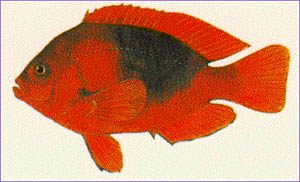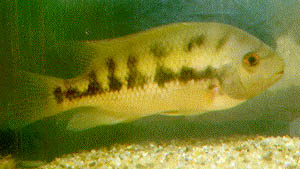
| Palaeos: |  |
Acanthomorpha |
| The Vertebrates | Acanthomorpha |
| Page Back | Unit Home | Unit Dendrogram | Unit References | Taxon Index | Page Next |
| Unit Back | Vertebrates Home | Vertebrate Dendrograms | Vertebrate References | Glossary | Unit Next |
|
Abbreviated Dendrogram
Euteleostei | Acanthomorpha |--Lampridiformes `--Labroidei |--Cichlidae `--Labridae |
Contents
|
Acanthomorpha: tunas, basses, founders, cods, and billfishes among many others.
Range: from the Late Cretaceous
Phylogeny: Ctenosquamata: Scopelomorpha + *: Lampridiformes + Labroidei.
Characters: True fin spines (not hardened rays) in dorsal, anal (and pelvic!?) fins.
Links: Taxonomy browser (Acanthomorpha); Ray-finned Fish Systematics; Lecture 7 -; Untitled Document. ATW020710.
 Lampridiformes:
opahs, crestfish, ribbonfish, oarfish (= Allotriognathi = Lampriformes) Deep-sea
fishes.
Lampridiformes:
opahs, crestfish, ribbonfish, oarfish (= Allotriognathi = Lampriformes) Deep-sea
fishes.
Range: from the Late Cretaceous or Late Paleocene, depending on the source.
Phylogeny: Acanthomorpha: Labroidei + *.
Characters: highly variable body form, usually deep-bodied or elongate; premaxilla excludes maxilla from gape; orbitosphenoid present in some; jaws highly protrusible with unique type of protrusible upper jaw (maxilla, instead of being ligamentously attached to the ethmoid and palatine, slides in and out with the highly protractile premaxilla); 84-96 total vertebrae; no fin spines (so why are they acanthomorphs?); pelvic fins with 0-17 rays (not spines?); pelvic fins placed anteriorly; dorsal fin elongate; swim bladder, when present, physoclistous; all lampridiform larvae have elongate dorsal and ventral rays; scales absent; large, red pelagic eggs; eggs develop in surface waters for approximately one month; marine pelagic (100-1000km depth).
Links: Lampridiformes; IWR: Taxa: Lampridiformes; Lampridiformes; (Type a title for your page here); Lampridiformes; temp; Oarfish, Regalecus glesne; Orders Summary; Lampridiformes (Mikko's Phylogeny); temp (very short, but useful); Ordem Lampridiformes; www . aquaria . ru (Russian: nice summary); Research Training Program Students- 2001. ATW030513.
 Labroidei:
cichlids, wrasses, damselfish, parrotfishes
Labroidei:
cichlids, wrasses, damselfish, parrotfishes
Range: currently tropical and subtropical, fresh water & marine, worldwide.
Phylogeny: Acanthomorpha: Lampridiformes + *. Cichlidae + Labridae.
Description: mouth small; advanced, toothed pharyngeal jaws (effectively two sets of jaws like the creature in Alien); outer jaws capture and hold, while inner jaws macerate (see Evolution of feeding mechanisms); fresh water & marine forms; "aggressive, territorial fishes with elaborate sex lives".
Image: Amphiprion ephippium (black-backed anenome), a damselfish from WWW Aquatic animals and aquatic plants of Thailand.
Notes: Apparantly Cichlids and Labrids are the only families placed in this group with high confidence. The pharyngeal jaw appears to be the only synapomorphy of the group and some evidence suggests that it is polyphyletic.
Links: IWR: Taxa: Perciformes; Labroidei; Larval Fish- Labroidei; Lippfischartige (Labroidei) (German: a beautiful and informative site, Best on the Web); ベラ亜目 (Japanese); Onderorde Labroidei (lipvisachtigen) (Dutch, with brief discussions of families); 魚の分類 系統的分類3(顎口上網 条鰓網 新鰭亜網 スズキ目その他) (Japanese); ADW: Advanced Search.
References: Barlow (2000). ATW030824.
 Cichlidae:
cichlids.
Cichlidae:
cichlids.
Range: fr lwOc. Probably originated in Gondwanan waters during K. Presently FW & brackish waters of SAm, Afr, Western Meditteranean, Sri Lanka & India.
Phylogeny: Labroidei: Labridae + *.
Description: single pair of nares with blind tube; enlarged macula? ampula? referred to as saggita; saggita marked with deep furrow to one side; main lateral line interrupted in posterior half of body; scales in lateral lines may be >100, usually 20-50; dorsal fin usually with 7-25 spines and 5-30 soft rays (posteriorly); spines in anal fin 3-15 (generally 3); soft rays 4-15 (a few with 30); intestine attaches to stomach on left side; breeding activities highly organized; almost all have some degree of parental care; parental care in 3 forms: mouthbrooding, substrate brooding, and substrate brooding of eggs then mouthbrooding of young.
Links: The Cichlid Room Companion - Cichlidae on-line; Family Cichlidae; IWR: Taxa: Perciformes: Cichlidae; Cichlid Research Home Page; FAMILIES - Detail; The Cichlid Room Companion - links (many links, most reviewed).
References: Barlow (2000).
Image: Cichlasoma sieboldi from Cichlid Research Home Page. ATW010528.
 Labridae:
wrasses
Labridae:
wrasses
Range: fr Pc. Currently widely distributed in marine waters.
Phylogeny: Labroidei: Cichlidae + *.
Description: Protrusible mouth; most jaw teeth with gaps between them; teeth usually procumbent; often 1-2 anterior teeth larger; molariform teeth on pharyngeal jaws; vertebrae 23-42; dorsal fin 8-21 spines (usually less than15), 6-21 soft rays; dorsal spines relatively small; anal fin 4-6 spines (often 3), 7-18 soft rays; caudal fin short & slightly rounded; cycloid scales, generally large to moderate, lateral line interrupted or continuous, often with abrupt curve in posterior if continuous; most are sand burrowers; carnivores on benthic invertebrates; also planktivores, and some small species remove ectoparasites of larger fishes; most species change color and sex with growth; maximum length about 2.3 m, many less than 15 cm.
Links: Family Labridae; IWR: Taxa: Perciformes: Labridae; labridae (Japanese).
References: Barlow (2000).
Image: Labrus bimaculatus from Food and Agriculture Organization of the United Nations. 010528
| Page Back | Unit Home | Page Top | Page Next |
checked ATW051001